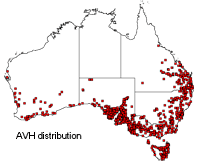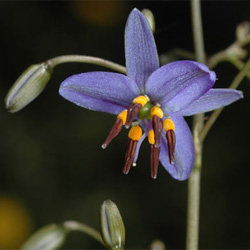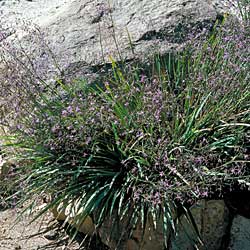Dianella revoluta
Blueberry Lily, Blue Flax-lily
Dianella revoluta , commonly known as blueberry lily, blue flax-lily, black anther flax-lily or spreading flax-lily is widely distributed within Australia and grows in extremely variable conditions, predominantly in sclerophyll, woodland and mallee forests.  Sometimes a dominant understorey species, it can form large spreading colonies. D. revoluta is an erect, hairless, perennial herb with a lifespan of many years, forming clumps and growing from rhizomes underground. D. revoluta grows to about 1m in height and has a diameter of up to 1.5m. The leaves are leathery, long and linear, varying in length from 1.5 – 8.5 cm and width from 4 – 15mm.
Sometimes a dominant understorey species, it can form large spreading colonies. D. revoluta is an erect, hairless, perennial herb with a lifespan of many years, forming clumps and growing from rhizomes underground. D. revoluta grows to about 1m in height and has a diameter of up to 1.5m. The leaves are leathery, long and linear, varying in length from 1.5 – 8.5 cm and width from 4 – 15mm.
This species flowers from spring to summer and has deep blue to purple inflorescences. The flowers stalks rise on wiry stems from the foliage, frequently exceeding it in height. The racemes are terminal panicles measuring up to 1.7m, branching several times into open sprays with one flower a day opening. This prolongs the flowering time for long periods. Flowers have six tepals, reflexed measuring 7-12mm in length and six stamens which are projected in a ring around the superior ovary. Filaments are long thick and yellow and anthers are brown to black in colour. The fruit are blue to purple and persist for many months after the flowers. Usually round in shape they measure from 4-10mm in diameter and contain 3-4 seeds.
This plant is horticulturally desirable because once it is established it is very hardy and has a wide moisture and temperature range excluding inland extremes. It is drought and frost resistant, is generally trouble-free and is grown for its distinctive strappy foliage as well as for its flowers and fruits. D. revoluta provides long periods of interest in gardens looking decorative with its compact, clumping and evergreen foliage. It is suitable for most soils, but prefers a well drained soil enriched with leaf mould and compost, and accepts part or full shade. It looks best in mass planting and makes a lovely understorey plant while adding texture. It is suitable for most rockeries and can be grown as a border or just adding quality to the bushland garden. Birds including parrots are also attracted by the fruit.
Propagation can be either from the ripe seed collected by hand and sown in spring or by the division of rhizomes which can be struck in moist shady conditions in light soil during cooler months in later winter. When young it is advisable to water plentifully. Fertilizing with blood and bone or a slow release fertilizer in spring encourages healthier plants and removing the old brown leaves is the only maintenance that is required for this plant.
Text by Robyn Collis (2007 Botanical Intern)
Name Meaning: Dianella revolutaDianella – from ‘Diana’ Roman Goddess of the hunt, often associated with woodlands, and the suffix ‘ella’ meaning small. The first specimen was collected from the island of Mauritius and was simply labeled ‘Diana’ by French botanist-explorer Philibert Commerson. revoluta– derived from ‘revolute’, referring to the leaves in-rolled margins |
References
Barber, G., 1991, Encyclopedia of Australian Gardening Vol. 31, Bay Books, Singapore, p. 972
Beeton, I., 1987, Australian National Botanic GardensGrowing Native Plants No.3, Australian Government Publishing Service, Australia, pp.65-66
Bradley, S., 2006, Propagation Basics how to make more plants from your plants, Hamlyn, Great Britain
Clarke, I. and Lees, H., 2001, Name that Flower the identification of flowering plants, Melbourne University Press, Melbourne, pp. 204-209
Cronin, L., 1992, Key Guide to Australian Wildflowers, Reed Books, New South Wales, p.178
Duncan, D., 2003, Pollination of Black-Anther Flax Lily (Dianella Revoluta) in Fragmented New South Wales Mallee, A report to the Australian Flora Foundation, School of Botany and Zoology, Australian National University, Canberra
Elliot, R.W. and Jones, D.L., 1984, Encyclopedia of Australian Plants Suitable for Cultivation Vol. 3, Lothian Publishing Company, Melbourne, p.260
Fairley, I. and Moore, P., 2002, Native Plants of the Sydney District an identification guide, Kangaroo Press, New South Wales, pp. 358-361
George, A., Executive Editor, Flora of Australia, Volume 45, Hydatellaceae to Liliaceae, Australian Government Publishing Service, Canberra, 1987, pp. 194-201
Hanks, M., 2001, Better Homes and Gardens Guide to Australian Natives, Murdoch Books, Australia, p. 45
Hutchinson, F., 1993, Creating a Native Garden for Birds, Simon & Schuster, Australia
Hutchinson, J., 1973, The Families of flowering Plants, 3 rd edition, Oxford, England, pp. 750-751
Mann, R., 1995, The Ultimate book of Flowers for Australian Gardens, Mynah, Australian, p. 180
Mason, J., 1997, Growing Australian Natives, Kangaroo Press, Australia, p. 95
Robinson, L., 1991, Field Guide to the Native Plants of Sydney, 3 rd edition, Kangaroo Press, New South Wales, pp. 229-232
Spencer, R. (ed), 2005, Horticultural Flora of South-eastern Australia – Flowering Plants Monocotyledons the identification of garden and cultivated plants, University of New South Wales Press, Australia, pp. 226-228
Stewart, A., 2004, Gardening Australia, Flora’s Native Plants a Definitive Guide to Australian Plants, ABC Books, Australia, P. 64
Wrigley, J. and Fagg, M., 2003, Australian Native Plants - Cultivation, Use in Landscaping and Propagation, fifth edition, Australia, p.153
Wrigley, J. and Fagg, M., 2002, Starting out with Natives, New Holland, New South Wales, p.60
Ralph, Murray, (2003), Growing Australian Native Plants from Seed, 2 nd edition, Bushland Horticulture, Australia, p.79
Australian National Botanical Gardens, Canberra, http://anbg.gov.au/cgi-bin/avh.cgi [accessed 24 th January 2007]
Australian National Botanical Gardens, Canberra, http://www.anbg.gov.au/cgi-bin/apni?taxon_name=dianella+revoluta%25 [accessed 24 th January 2007]
Duncan, D., Nicotra, A. and Cunningham, S., 2004, , High self-pollen transfer and low fruit set in buzz-pollinated Dianella revoluta, Australian Journal of Botany 52(2): 185 – 193
Greening Australia Victoria, 2007, Seed Germination Data Sheet No.6 The Lily Family (liliaceae), August 1996
Royal Botanic Gardens Sydney, New South Wales, accessed 24 th January 2007 http://plantnet.rbgsyd.nsw.gov.au/
![An Australian Government Initiative [logo]](/images/austgovt_brown_90px.gif)



